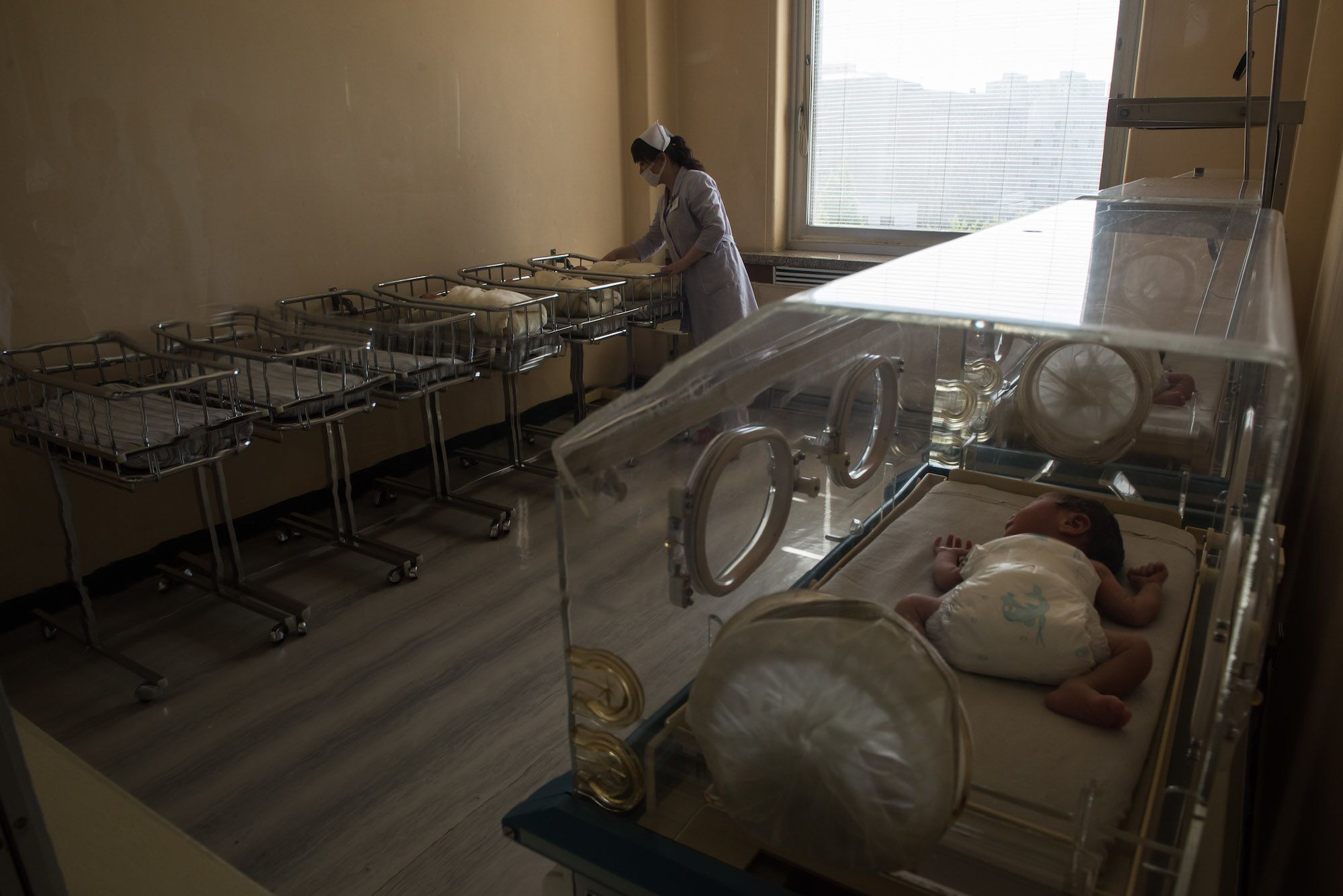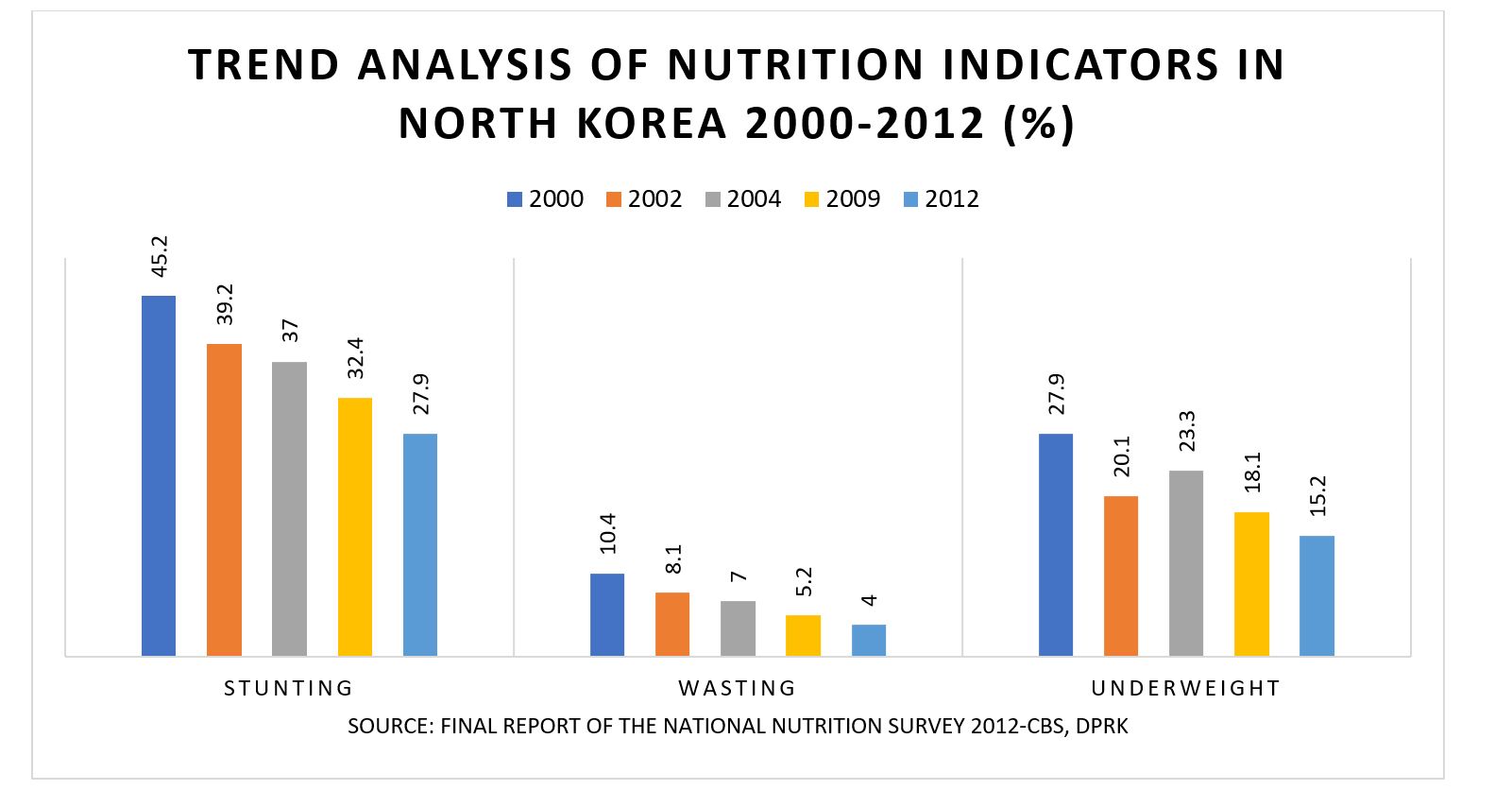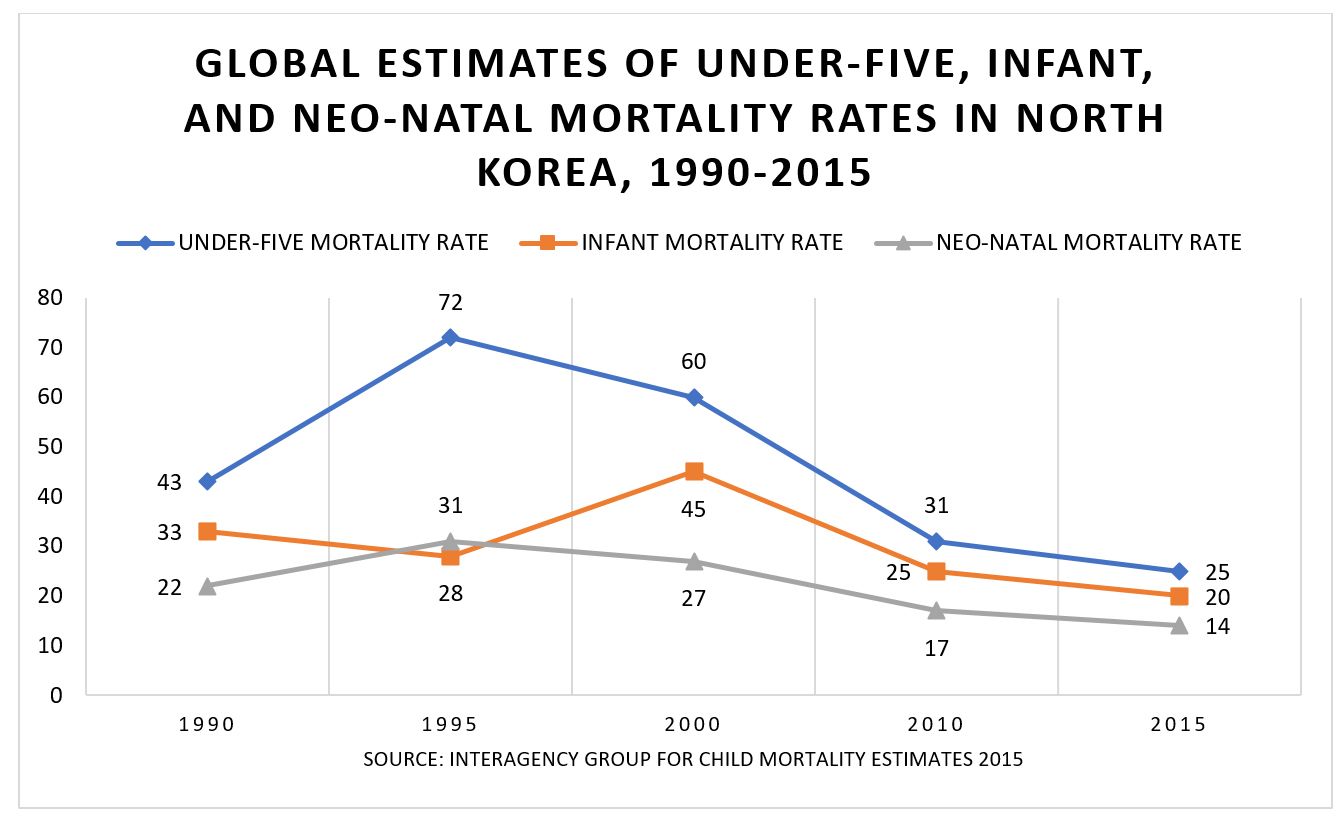The Gathering Health Storm Inside North Korea
J. Stephen Morrison, Victor Cha, Rebecca Hersman, Kee B. Park, Ambassador Mark Dybul, Margaret "Peggy" Hamburg, Ambassador Jimmy Kolker, , and Christine Wormuth. "The Gathering Health Storm Inside North Korea." CSIS Commission on Strengthening America's Health Security, Center for Strategic and International Studies, May 08, 2018. Accessed October 01, 2025. https://healthsecurity.csis.org/articles/the-gathering-health-storm-inside-north-korea/

Health realities in North Korea are grim, poorly understood, and seldom studied as part of the larger problem of potential instability on the Korean peninsula. Yet, while accurate health data is often elusive and there is evidence of recent gains, the advanced state of deterioration is undeniable. Moreover, North Korea’s health decay is genuinely exceptional: in the dangers it poses, its unusual root causes, the astonishing contrast between North and South Korea, and the limited number and limited impact of key external organizations. This peculiar situation merits much higher attention, as we ponder the uncertain future of North Korea and the region at large–-whether the situation worsens, improves due to ongoing talks, or simply stays the same. There are proactive high-level diplomatic steps that the United States and others can and should initiate today to improve the immediate health and humanitarian situation inside North Korea, while planning for the future.
When it comes to health security in North Korea, much of the discussion has focused on suspicions that Pyongyang maintains clandestine stocks of chemical and biological weapons. Nonetheless, another conspicuous and immediate health security threat posed by North Korea is a more conventional one—the very tangible possibility that instability or conflict in North Korea could prompt a mass exodus of North Korean refugees carrying multidrug resistant tuberculosis (MDR-TB) to China and South Korea.
North Korea has an exceptionally high incidence of untreated drug-susceptible tuberculosis and rising MDR-TB. Though there has been no national survey on MDR-TB, independent experts estimate there are 5,000 to 6,000 MDR-TB cases, and there’s a good chance the true numbers are much higher. The Eugene Bell Foundation tested 947 TB samples in 2007–2009 and found that 76.9 percent of TB patients had MDR-TB. At present, there are no fewer than 120,000 patients receiving TB treatment through international programs. As the table below attests, North Korea is a glaring standout globally with respect to tuberculosis.
| Estimates of TB Burden (2016) | North Korea | South Korea | China | Russia | India | South Africa |
|---|---|---|---|---|---|---|
| Mortality Rate Per 100,000 (Excludes HIV + TB) | 43 | 5.1 | 2.8 | 8.2 | 32 | 41 |
| Incidence Rate Per 100,000 (Includes HIV + TB) | 513 | 77 | 64 | 66 | 211 | 781 |
| Incidence Rate Per 100,000 (MDR/RR-TB) | 22 | 4.8 | 5.2 | 44 | 11 | 34 |
| Source: World Health Organization Global Tuberculosis Report 2017 | ||||||
Though the socialized health system established 60 years ago does reach every community and includes many dedicated career personnel, that means little when it is woefully underfinanced and composed of many undertrained staff, barren medicine cabinets, and 60-year-old diagnostics. The only way to address TB and other infectious diseases effectively is through a holistic approach to the fundamental problems of poverty in North Korea, rooted in the lack of clean water, basic nutrition, and electrical power. Elementary preparedness capacities to prevent, detect, and respond to pandemics fall far short. This is a government whose only recourse during previous health crises (Middle East respiratory syndrome [MERS], Ebola, and pandemic flu) was a panicked shutdown.
The second grave health security danger North Korea poses, over the medium to long term, is of a system-wide internal collapse of the health system arising from its decrepit health infrastructure, chronic malnutrition, and the sudden shock of a pandemic or natural disaster. While such a destabilizing implosion might have a low probability, it is not out of the question and would have high impact, were it to ever happen.
A large number of North Koreans—those outside the privileged capital, Pyongyang—have been largely abandoned by their central government. Roughly half live in extreme poverty, many subjected to chronic malnutrition. North Korea’s state of human development is comparable to that of Sierra Leone, Myanmar, Yemen, and Haiti.
The United Nations estimates that 10.5 million people, or 42 percent of the population, are undernourished. Only 16 percent of households consume at acceptable, secure food levels. Every year begins with a grave national food deficit. Climate change is raising the frequency of both drought and flooding.
North Korea’s biggest national tragedy, arguably, is that such a conspicuously large number of its citizens are stunted—a profound, irreversible loss of the nation’s human potential due to a permanent inability to develop physically and mentally. According to North Korea’s own estimates, contained in its 2012 National Nutritional Survey, stunting dropped between 2000 and 2012 from 45.2 percent to 27.9 percent, aided by a rise in health commitments from the government (from 5.9 percent of gross domestic product in 2000 to 6.4 percent in 2014), expanded UN efforts, and the absence in that period of severe drought. If those numbers are accurate (UN estimates track closely with the North Korean numbers), roughly 3 in 10 citizens at the least are stunted, a function of the chronic lack of micronutrients, proteins, and oils.

How exactly did North Korea reach this point? Most fundamentally, it is because North Korea’s leadership has disregarded the public’s welfare in pursuit of grossly skewed national priorities, most significantly developing its nuclear weapons program. It was not always this way. For a long time, it looked like North Korea was doing as well—if not much better—than South Korea. North Korea inherited basic health infrastructure created under the Japanese occupation. Over the course of the 1950s and 1960s, North Korea’s gross domestic product exceeded South Korea’s, and the North Korean state dramatically expanded its investments in infrastructure and industry. It was not until the early 1970s that the North and South’s developmental pathways diverged.
| Indicators | North Korea | South Korea |
|---|---|---|
|
Total Population (2017) |
25.3 million |
51.2 million |
|
Life Expectancy At Birth (2016) |
72 years old |
82 years old |
|
Average Height (2009) |
165.5 - 170.5 cm |
173.5 cm |
|
Gross Domestic Product Per Capita (2017) |
$1,700 |
$39,400 |
|
Paved Roadways (2016) |
2.8 percent |
92.4 percent |
|
Electrification (2016) |
30 percent |
100 percent |
|
Active Military Personnel (2017) |
1,190,000 |
630,000 |
| Sources: World Bank, CIA Factbook, Journal of Economics and Human Biology, IISS | ||
North Korea’s deterioration in the years since is the result of choice, priorities, and neglect—not accident—stretching across the Kim family dynasty. It grows out of a form of governance, executed over the decades, that categorizes populations into politically defined castes and gives excessive preference to protecting elites. It emerged from the shocks of the 1990s when Soviet subsidies suddenly ended and chronic mismanagement created a famine in 1994–1998 that left over 1 million dead. It flows from the conscious decision, in the post–Cold War era, to radically center resources and power in the hands of the military, with huge shares dedicated to the pursuit of nuclear weapons and an ambitious missile program, as part of North Korea’s strategy to counter the perceived threat from the United States. Implicitly, the health decay of the past 25 years is the flip side, the price North Korea’s citizens have paid for the regime’s quest to concentrate its grip on power and resources and survive by entering the nuclear club.
These realities notwithstanding, international engagement in health and related humanitarian activities has not only been possible but actually expanded in recent years, creating an important but limited foothold inside an otherwise walled-off North Korea. The World Health Organization (WHO), the UN International Children’s Emergency Fund (UNICEF), the World Food Program (WFP), the Global Fund to Fight AIDS, Tuberculosis and Malaria, Gavi, the International Committee of the Red Cross, as well as European and a few intrepid American Christian and other nongovernmental groups, have achieved some success in identifying and treating those with MDR-TB, hepatitis B, and malaria; in addition, they have raised immunization coverage and lowered the mortality of mothers and children under age five.

Prospects for continued international engagement have, however, declined sharply.
Three rounds of ever-tougher international sanctions came into force in 2017 in response to North Korea’s accelerated nuclear and missile programs. China for its part tightened controls over critical North Korean exports (seafood, coal, textiles) and energy imports. In combination, these measures have made it dramatically more difficult for external providers of health and humanitarian assistance to continue to operate inside North Korea. Indeed, these intensifying geopolitical pressures now call into question these programs’ very viability. And in this overheated context, decisions by donors not to support humanitarian appeals, or to suspend, scale back, or end programs, have stirred debate over whether political considerations have come into play.
Though humanitarian exemptions are written into all the sanctions measures, these carve outs have become increasingly difficult to pursue, as international and nongovernmental organizations alike openly fear any appearance of breaking sanctions. In the meantime, transfer banking arrangements have collapsed, and donor pledges to WFP, UNICEF, and other UN appeals have declined dramatically: only 660,000 of the 4.3 million in need received food assistance in 2017. When there has been more external funding, the WFP alone had reached upward of 6 million vulnerable, food-insecure children and pregnant women.
The movement of commodities through clearances in China and elsewhere have run up against formidable logistical barriers (the December 2017 UN Security Council sanctions, for instance, forbid any metal). External providers who remain operational inside North Korea, with reduced budgets and in-country staff, spend inordinate time navigating sanctions. The North Korean government’s conspicuous underinvestment in its own people and its record of aggressive sanctions evasion feed an external skepticism and resignation: that there is simply not much good we can do in the health and humanitarian fields in the midst of the current crisis that North Korea has brought on itself and the world.
The Global Fund’s decision to close its three-year, $44-million TB and malaria program is the most recent, dramatic evidence of how difficult it has become for donors to adhere to their rules of accountability in this environment. For the Fund and others, there have been long-standing issues of accountability, tied to the approach taken by the North Korean government, that predate the tightening of sanctions.
Future events could cut in two contrary directions, and we need to prepare for each.
If current trends persist, intensified pressures will continue to squeeze the external health and humanitarian infrastructure, and much of what has been erected in the past decade may collapse. Unless there is a concerted push by major donors to increase resources and make it more feasible for humanitarian providers to operate in North Korea, there will be limited hope of success for the UN appeal, issued April 12, which calls for $111 million to meet the basic food, health, and sanitation requirements of 6 million people. Instead, gains in TB, malaria and hepatitis control, childhood immunization, nutrition focused on children under five and lactating and pregnant women, and strengthening of primary services will likely be reversed. The risk that MDR-TB will spread internally and into the region will rise. Under this scenario, a majority of the population could slip into an escalating human crisis, at a moment when key international organizations are increasingly less able to address these needs.
Paradoxically, something quite different might also happen.
If talks between South and North Korea advance, and/or talks between the United States and North Korea go anywhere, attention could shift suddenly to what type of conciliatory actions might be undertaken that could demonstrate concrete progress without lifting sanctions. That could swing open the gate for renewed health and humanitarian initiatives in North Korea. Efforts to focus on reducing these critical health security risks as part of early gestures in a negotiation process would not only meet immediate humanitarian needs but would also address serious health threats to countries beyond North Korea’s borders. Just as we need to prepare for new risks, we need to prepare for new opportunities. The United States must think ahead, with the South Koreans, Chinese, and implementing organizations in particular, about how to expedite investments in clean water, nutrition, TB and malaria control, and immunizations inside North Korea.
The one clear conclusion that emerges from North Korea’s clouded, confusing, and highly dangerous situation is that careful high-level advance planning should accelerate right away to address North Korea’s health insecurity through a coordinated international approach. It’s important to maintain the maximum pressure through sanctions that have brought the North Korean regime to consider the benefits of a new approach. But more can and should be done to ensure today that adequate resources are available and that humanitarians are able to operate effectively and free of extreme restrictions. And far more can and should be done to position humanitarian programs to expand quickly if opportunity strikes.